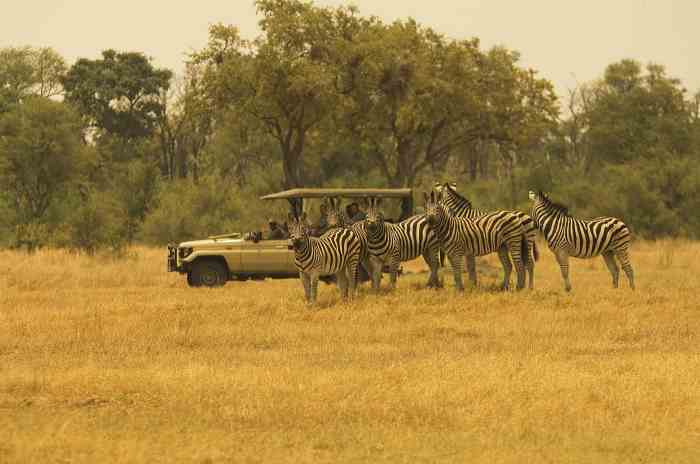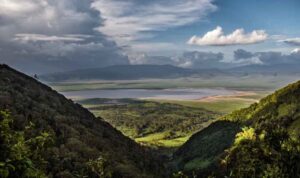Hwange National Park (Zimbabwe) is a mesmerizing destination teeming with diverse wildlife and breathtaking landscapes, drawing visitors into a world of natural wonders and conservation efforts.
As you delve deeper, you’ll uncover the intricate balance between flora and fauna, the challenges faced in preserving this biodiversity, and the array of activities awaiting adventurous travelers.
Overview of Hwange National Park: Hwange National Park (Zimbabwe)

Hwange National Park, located in north-western Zimbabwe, is the country’s largest national park covering an area of approximately 14,650 square kilometers. It is renowned for its diverse wildlife and varied landscapes, making it a popular destination for safari enthusiasts and nature lovers alike.
Location and Size
Hwange National Park is situated about an hour south of Victoria Falls and is easily accessible by road. The park’s vast size allows for a wide range of habitats, including grasslands, forests, and mopane woodlands, providing a diverse environment for its inhabitants.
Diverse Wildlife
- The park is home to over 100 species of mammals, including the Big Five – elephant, lion, leopard, buffalo, and rhinoceros. It also boasts a rich birdlife, with over 400 species recorded within its borders.
- Hwange National Park is famous for its large elephant population, with estimates of up to 45,000 elephants roaming the park. Visitors can witness these majestic creatures up close at waterholes during the dry season.
- Other wildlife that can be spotted in the park include giraffes, zebras, cheetahs, and a variety of antelope species such as kudu, sable, and impala.
Significance as a Conservation Area
Due to its rich biodiversity and crucial role in wildlife conservation, Hwange National Park plays a significant role in preserving the natural heritage of Zimbabwe. The park provides a safe haven for endangered species and serves as a vital ecosystem for the region’s flora and fauna.
Flora and Fauna

Hwange National Park is home to a diverse array of plant and animal species, creating a rich and vibrant ecosystem.
Plant Species
The park boasts a variety of plant species that are native to the region, including Mopane woodlands, teak forests, and grasslands. The iconic Baobab trees also dot the landscape, providing a unique and picturesque backdrop to the park’s scenery.
Animal Species
Hwange National Park is renowned for its impressive wildlife population, with iconic species such as African elephants, lions, leopards, and buffalo calling the park home. Other notable inhabitants include giraffes, zebras, cheetahs, and a wide range of bird species, making it a paradise for wildlife enthusiasts.
Interactions between Flora and Fauna
The relationship between the flora and fauna in Hwange National Park is a delicate balance that sustains the ecosystem. For example, elephants play a crucial role in shaping the landscape by feeding on trees and creating pathways for other animals. The diverse plant species provide food and shelter for the animals, creating a self-sustaining environment where each species contributes to the overall health of the ecosystem.
Conservation Efforts

The conservation efforts in Hwange National Park are crucial in preserving the rich biodiversity of this natural habitat. Various programs and initiatives have been implemented to protect the flora and fauna within the park.
Community Involvement, Hwange National Park (Zimbabwe)
The local community plays a vital role in conservation efforts in Hwange National Park. Community-based conservation programs have been established to engage and empower local residents in protecting the park’s wildlife and natural resources. Through education, training, and collaborative projects, the community is actively involved in safeguarding the park for future generations.
Challenges in Biodiversity Preservation
Preserving the biodiversity of Hwange National Park faces several challenges. These include poaching, habitat loss due to human activities, climate change, and conflicts between wildlife and local communities. Efforts are being made to address these challenges through increased anti-poaching measures, habitat restoration projects, community outreach programs, and sustainable development initiatives.
Tourist Attractions and Activities
:max_bytes(150000):strip_icc()/GettyImages-141301731-58a4129c3df78c4758f2f2fa.jpg?w=700)
When visiting Hwange National Park, tourists can experience a wide range of attractions and activities that showcase the park’s natural beauty and wildlife diversity.
Popular Tourist Attractions
- Victoria Falls: While not located within the park boundaries, many visitors to Hwange National Park also take the opportunity to visit the majestic Victoria Falls, one of the Seven Natural Wonders of the World.
- Panoramic Viewing Platforms: Scattered throughout the park, these platforms offer stunning views of the surrounding landscapes, perfect for watching wildlife and enjoying breathtaking sunsets.
- Ngweshla Pan: A popular spot for game viewing, especially during the dry season when animals gather around the water source.
Activities for Visitors
- Game Drives: One of the most popular activities in the park, game drives offer visitors the chance to see a wide variety of wildlife, including elephants, lions, giraffes, and more.
- Walking Safaris: For a more intimate and up-close experience with nature, guided walking safaris are available, allowing visitors to explore the park on foot with experienced guides.
- Bird Watching: With over 400 bird species recorded in Hwange National Park, bird watching is a favorite activity for nature enthusiasts and bird lovers.
Cultural Experiences and Events
- Visit Local Communities: Tourists can engage in cultural exchanges by visiting nearby villages and interacting with local communities to learn about their traditions and way of life.
- Boma Dinner: Experience traditional Zimbabwean cuisine and entertainment at a Boma dinner, a unique cultural event that often includes music, dance, and storytelling.
- Celebrations and Festivals: Depending on the time of year, visitors may have the opportunity to participate in local festivals or celebrations that showcase the rich cultural heritage of the region.
In conclusion, Hwange National Park (Zimbabwe) stands as a beacon of conservation, offering unforgettable experiences and a deep connection to the wild heart of Africa. Plan your journey to this enchanting park and immerse yourself in its beauty and significance.






